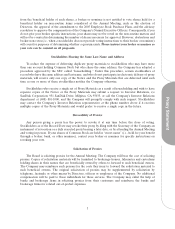SanDisk 2013 Annual Report Download - page 21
Download and view the complete annual report
Please find page 21 of the 2013 SanDisk annual report below. You can navigate through the pages in the report by either clicking on the pages listed below, or by using the keyword search tool below to find specific information within the annual report.
Committee was a current or former executive officer or employee of the Company. See ‘‘Certain
Transactions and Relationships’’ for a description of a transaction occurring during fiscal year 2013
involving Mr. Federman and a transaction occurring during fiscal year 2013 involving Dr. Hu, each of
which requires disclosure by the Company under the SEC’s rules requiring disclosure of certain
relationships and related-party transactions. None of the Company’s executive officers served as a director
or a member of a compensation committee (or other committee serving an equivalent function) of any
other entity, the executive officers of which served as a Director or member of the Compensation
Committee during the fiscal year ended December 29, 2013.
Analysis of Risk in Compensation Programs. In setting compensation, the Compensation Committee
also considers the risks to the Company’s stockholders, and the Company as a whole, arising out of the
Company’s compensation programs. In March 2014, the Company’s management met to discuss and assess
the risk profile of the Company’s compensation programs. Their review considered risk-influencing
characteristics of the overall structure and individual components of the Company’s compensation
program, including the Company’s base salaries, incentive plans and equity plans. A report regarding
management’s findings was provided to the Compensation Committee for its review and consideration.
Following this review and consideration, the Compensation Committee concurred with management’s
conclusions that the Company’s compensation policies were not reasonably likely to have a material
adverse effect on the Company and included many features that mitigate the likelihood of excessive
risk-taking, including those discussed below.
Balance of Compensation. Individual elements of the Company’s compensation program include
base salaries, incentive compensation, and for certain of its employees, share-based awards. By providing a
mix of different elements of compensation that reward both short-term and long-term performance, the
Company’s compensation programs as a whole provide a balanced approach to incentivizing and retaining
employees, without placing an inappropriate emphasis on any particular form of compensation.
Objective Company Results and Pre-established Performance Measures Dictate Annual Incentives.
Under the Company’s cash-based incentive plan, payments are subject to the satisfaction of specific annual
performance objectives established by the Compensation Committee in advance and may be subject to
reimbursement or forfeiture under the Company’s clawback policy. These performance objectives were
directly and specifically tied to the Company’s fiscal year 2013 diluted non-GAAP earnings per share, as
well as the achievement of strategic objectives for fiscal year 2013.
Use of Long-Term Incentive Compensation. Share-based long-term incentive compensation that vests
over a period of years is a key component of the total compensation of many of the Company’s employees.
This vesting period encourages the Company’s executives and other employees to focus on sustaining and
improving the Company’s long-term performance. These grants are generally made annually, so executives
and other key employees always have unvested awards that could decrease significantly in value if the
Company’s business is not managed for the long term.
Internal Processes Further Restrict Risk. The Company has in place additional processes to limit risk
to the Company from its compensation programs. Specifically, sales commission payments are subject to
multiple internal controls regarding payout terms and payroll programs. Additionally, financial results
upon which incentive compensation payments are based are subject to regular review and audit. In
addition, the Company from time to time engages an external compensation consulting firm to assist in the
design and review of the Company’s compensation programs, as well as external legal counsel to assist with
the periodic review of the Company’s compensation plans to ensure compliance with applicable laws and
regulations.
13
Proxy Statement
























